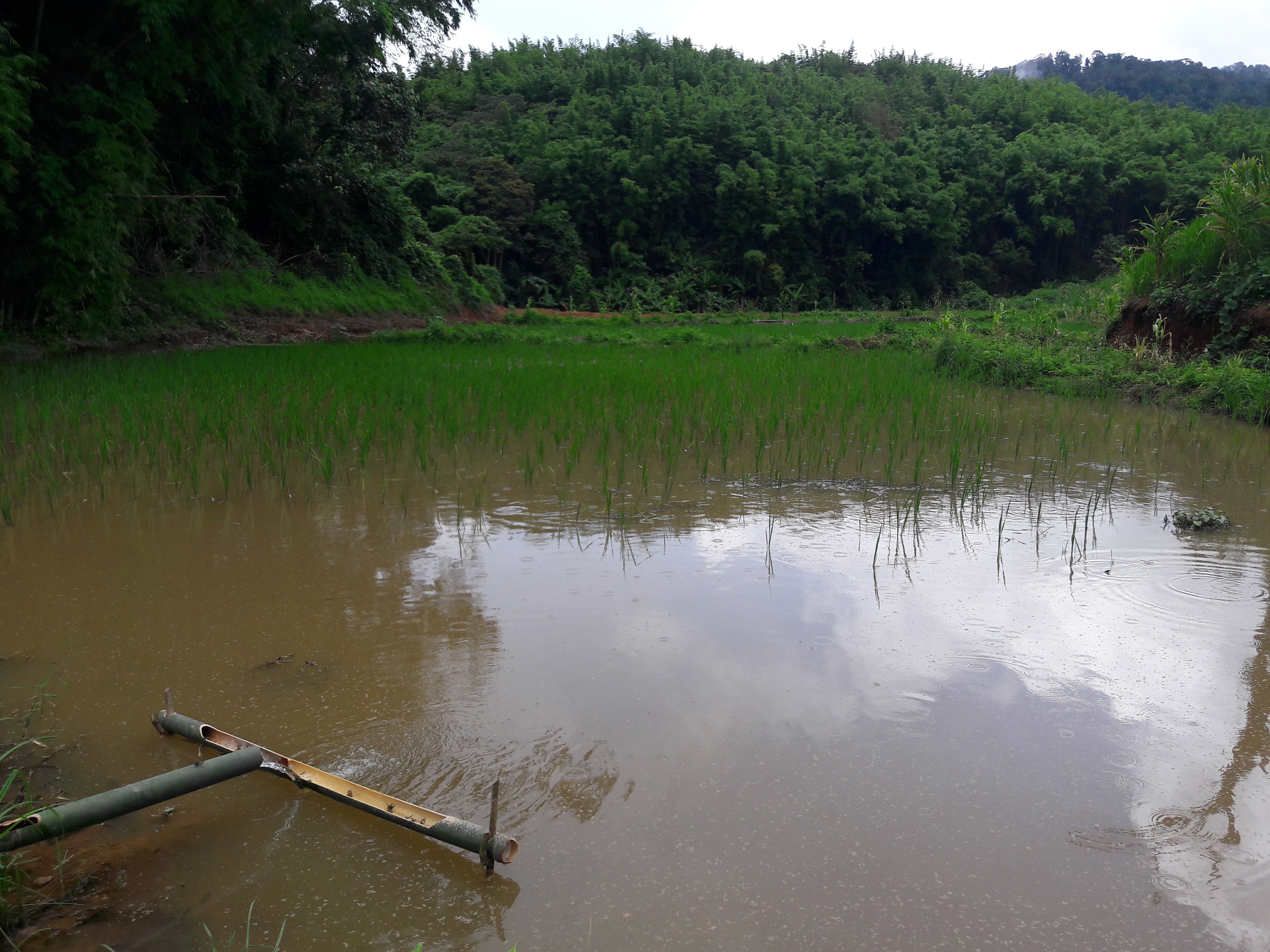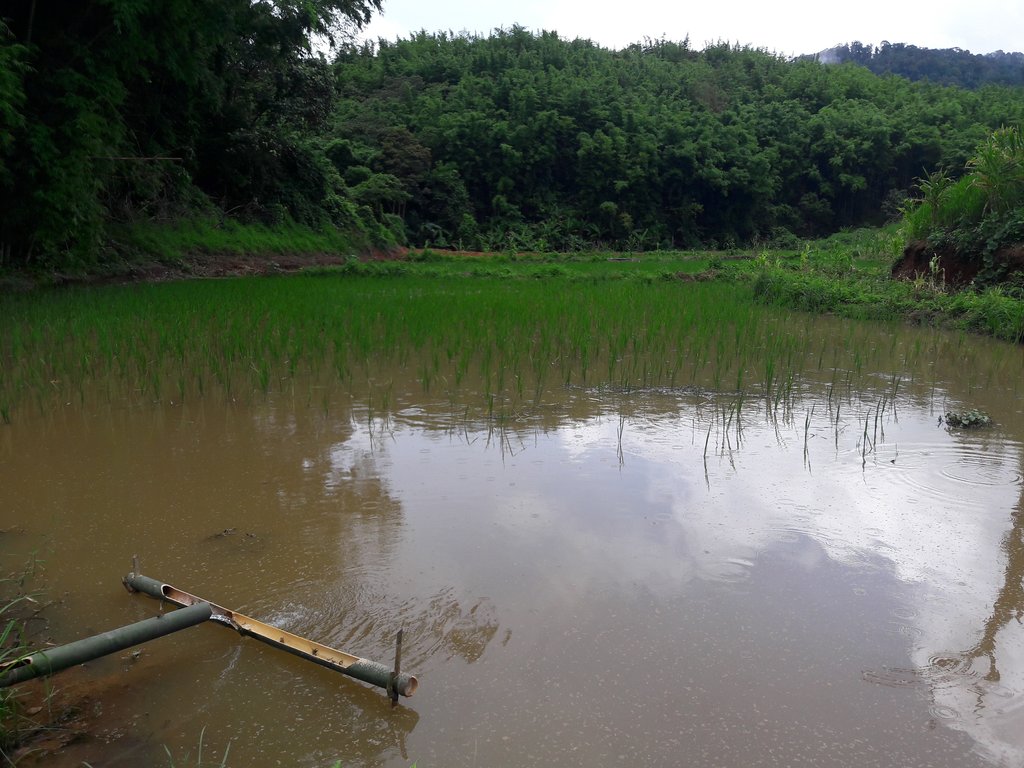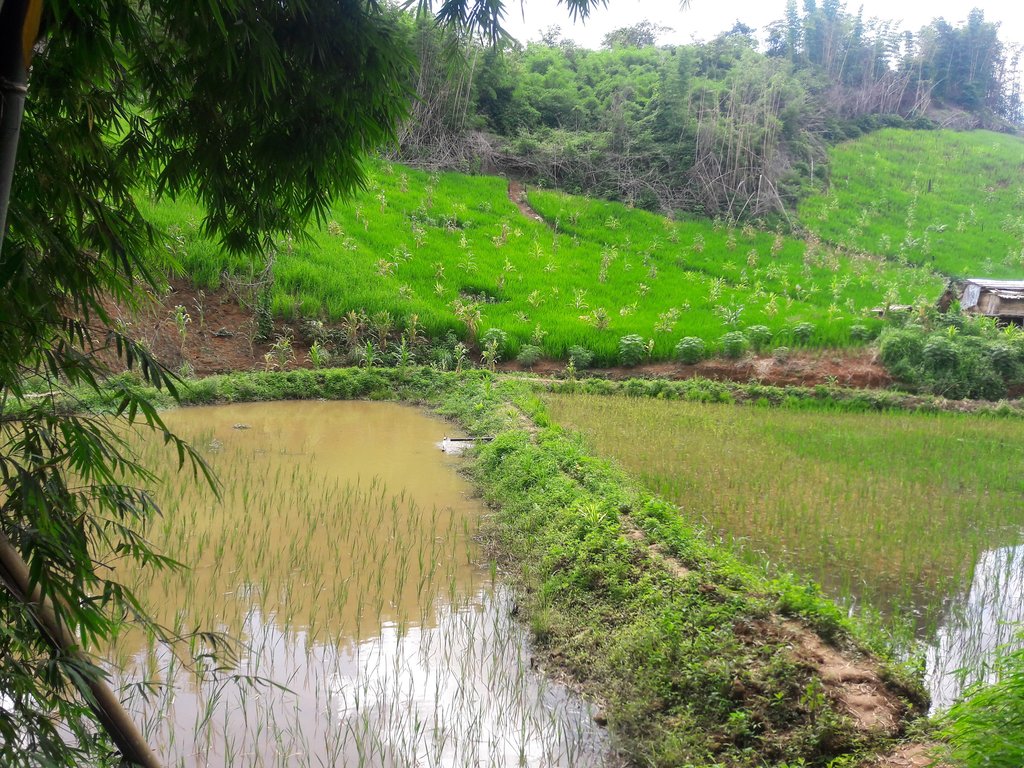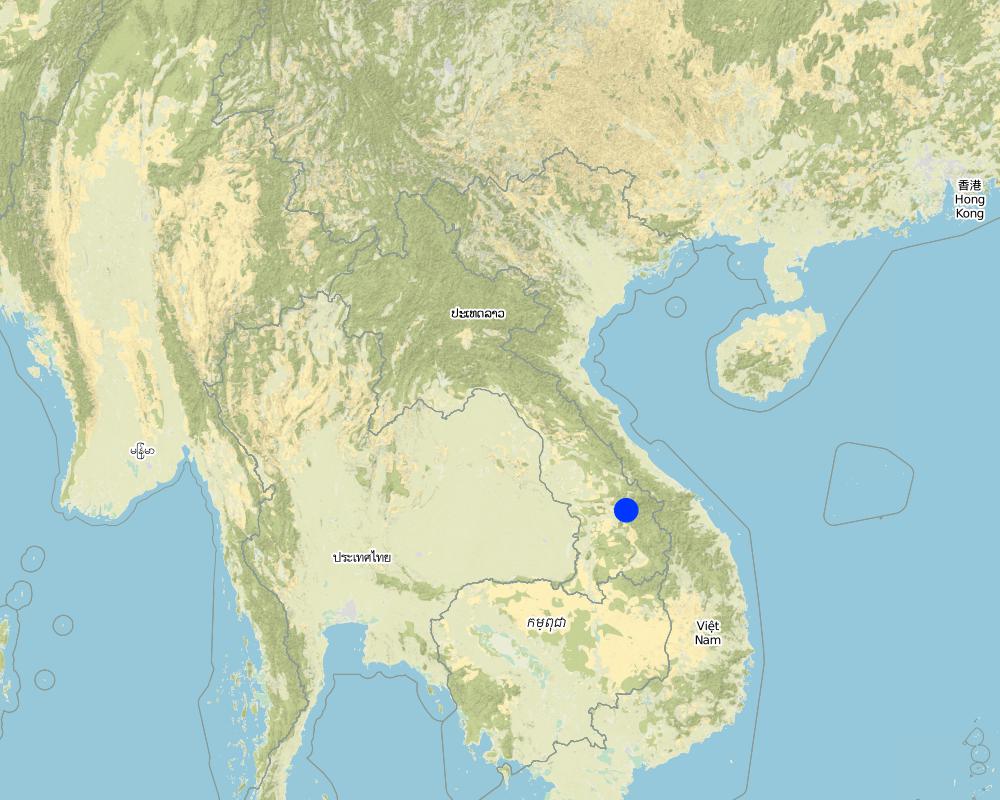ກະສິກຳປະສົມປະສານ ການລ້ຽງປາໃນເຂົ້າ [Lao People's Democratic Republic]
- Creation:
- Update:
- Compiler: kang phanvongsa
- Editors: xaiyarsid khamphila, Bounthanom Bouahom, Pasalath Khounsy, Sanoussi Razaki, kang phanvongsa
- Reviewers: Nicole Harari, Oulaytham Lasasimma, Stephanie Jaquet, Alexandra Gavilano
technologies_2928 - Lao People's Democratic Republic
View sections
Expand all Collapse all1. General information
1.2 Contact details of resource persons and institutions involved in the assessment and documentation of the Technology
Key resource person(s)
land user:
ທ້າວ ເຄນ
Lao People's Democratic Republic
Name of project which facilitated the documentation/ evaluation of the Technology (if relevant)
Scaling-up SLM practices by smallholder farmers (IFAD)Name of the institution(s) which facilitated the documentation/ evaluation of the Technology (if relevant)
National Agriculture and Forestry Research Institute (NAFRI) - Lao People's Democratic Republic1.3 Conditions regarding the use of data documented through WOCAT
The compiler and key resource person(s) accept the conditions regarding the use of data documented through WOCAT:
Ja
1.4 Declaration on sustainability of the described Technology
Is the Technology described here problematic with regard to land degradation, so that it cannot be declared a sustainable land management technology?
Nee
2. Description of the SLM Technology
2.1 Short description of the Technology
Definition of the Technology:
ການລ້ຽງປາໃນນາເຂົ້າ ເພື່ອປັບປຸງການນໍາໃຊ້ທ່ີດິນ
2.2 Detailed description of the Technology
Description:
ລະບົບການລ້ຽງປາໃນນາເຂົ້າ ແມ່ນ ການປະສົມປະສານ ລະຫວ່າງ ນາເຂົ້າ ແລະ ໜອງປາ ຢ່າງມີປະສິດທິຜົນ. ນີ້ແມ່ນ ແນວຄິດລິເລີ່ມ ຂອງປະຊາຊົນທີ່ຢູ່ໃກ້ຊິດຕິດແທດ ກັບທຳມະຊາດມາດົນນານ ເກີດມີແນວຄິດປຽ່ນແປງໃໝ່ໃນການຫັນມາ ເຮັດໃຫ້ເກີດປະໂຫຍດສູງສຸດ ໂດຍການຫັນປຽ່ນຈາກການເຮັດໄຮ່ ແບບເລື່ອນລອຍລົງມາເຮັດນາ ໃນເນື້ອທີ່ດີນຕອນດຽວ ໃຫ້ມີຄວາມສາມາດນຳໃຊ້ໄດ້ຍາວນານ, ການລ້ຽງປາໃນນາເຂົ້າ ກໍ່ເປັນເຕັກນິກໜື່ງທີ່ ສຳຄັນໃນການນຳໃຊ້ ທີ່ດີນແບບຄົງທີ່. ການລ້ຽງປາໃນນາເຂົ້າແມ່ນລ້ຽງໃນພື້ນທີ່ ທີ່ມີຄວາມເໝາະສົມ ໂດຍສະເພາະແມ່ນພື້ນທີ່ທົ່ງນາ ທີ່ມີນ້ຳຕະຫຼອດປີໃນລະດູແລ້ງ ແລະ ລະດູຝົນ ເປັນນາທີ່ທຢູ່ໃກ້ແຄມຫວ້ຍຮອ່ງ ຫຼື ແມ່ນ້ຳແລະຊົນລະປະທານ ສາມາດລະບາຍນ້ຳເຂົ້າ ແລະ ອອກຈາກນາໄດ້ເປັນຢ່າງດີ ເມືອງຕະໂອ້ຍ ກໍ່ເປັນເມືອງໜື່ງທີ່ມີພື້ນທີ່ ໃນການເຮັດນານວນຈຳກັດ ສວ່ນຫຼາຍທົ່ງນາ ແມ່ນ ຢູ່ຕາມຮອ່ມພູ ແລະ ຕີນພູ ໂດຍອາໃສນ້ຳຈາກທຳມະຊາດເປັນສວ່ນໃຫ່ຍ; ການບຸກເບີກເນື້ອທີ່ ແມ່ນ ໃຊ້ແຮງງານຄົນໃນຄອບຄົວ ຫຼື ຈ້າງລົດໄຖ ມາບຸກເບີກໃຫ້ ໂດຍການຂຸດ ຫຼື ຍູ້ດີນຕາມຮອ່ມພູເປັນຄັນຄູກັ້ນນ້ຳ ແລ້ວປັບພື້ນທີ່ ໃຫ້ມີຄວາມຊັນເລັກນອ້ຍ ເຮັດໃຫ້ນ້ຳເຂົ້າທົ່່ວເຖິ່ງຕາມພື້ນທີ່ນາ ເຊີ່ງເປັນລັກສະນະນາຂັ້ນໄດ ກໍ່ສາມາດປູກເຂົ້າໄດ້ ເຕັກນິກການລ້ຽງປາໃນນາເຂົ້າ ແມ່ນ ຈະເຮັດແຕກຕ່າງຈາກທົ່ງນາປົກກະຕິ ໂດຍມີການຈັດການພື້ນທີ່ ເພ່ືອປ້ອງກັນຄວາມສ່ຽງຈາກໄພພິບັດຈາກທຳມະຊາດ ຈາກການໄຫຼຂອງນ້ຳເຊາະເຈືອນໜ້າດີນ ການເຮັດນາລ້ຽງປາ ຕອ້ງເຮັດຄັນຄູສູງໃຫ່ຍເຮັດທໍ່ລະບາຍນ້ຳເຂົ້າ ແລະ ອອກຈາກນາໄດ້ສະດວກ ເຮັດຮ່ອງ ຫຼື ຄອງຕາມຂອບນາ ປຽ່ນທິດການໄຫລຂອງນ້ຳ ເພ່ືອປ້ອງກັນການເຊາະເຈືອນຂອງຄັນນາ ການເຮັດນາປະສົມປະສານກັບການລ້ຽງປາ ແມ່ນ ເພື່ອນຳທີ່ ດີນໃຫ້ເກີດປະໂຫຍດ ເພື່ອຜົນຜະລິດເຂົ້າ ແລະ ປາໃຫ້ຫຼາຍຂ້ືນ ເພື່ອຄ້ຳປະກັນສະບຽງອາຫານໃນຄອບຄົວ ແລະ ເພີ່ມລາຍໄດ້ໃຫ້ຊາວກະສິກອນ ແລະ ເພື່ອປົກປັກຮັກສາພື້ນທີ່ ການຜະລິດໃຫ້ໄດ້ນຳໃຊ້ຍາວນານ ຕອ້ງໄດ້ອາໃສ່ເຕັກນິກ.
ອຸປະກອນນຳເຂົ້າຊວ່ຍ ເປັນຕົ້ນ ແມ່ນ ທ່ໍລະບາຍນ້ຳເພ່ືອເຮັດຊົນລະປະທານ ຂະໜາດນອ້ຍສະເພາະຄອບຄົວ ມີແນວພັນເຂົ້າ, ແນວພັນປາ, ພ້າ,ຈົກ, ສຽມ, ຊວ້ນ, ກຽ່ວ ທີ່ຮັບໃຊ້ເຂົ້າໃນການຜະລິດ, ໃນການເຮັດເຕັກນິກລ້ຽງປາໃນນາເຂົ້າ ທັງ 2 ຢ່າງ ແມ່ນ ມີຜົນປະໂຫຍດເຊິ່ງກັນແລະກັນເຊັ່ນວ່າ: ເສດອາຫານ ແລະ ຕະກອນໃນນ້ຳ ( ເມື່ອປາກິນແລ້ວຂັບຖ່າຍອອກມາ) ສາມາດເປັນຝຸ່ນໃຫ້ແກ່ຕົ້ນເຂົ້າໃນນາ ແລະ ຊວ່ຍເພີ່ມອີນຊີວັດຖຸໃນດີນ ຕົ້ນເຂົ້າໃນນາເປັນບອ່ນລີ້ຊອ້ນ ແລະ ເປັນບອ່ນຫາກິນຕາມປ່າເຂົ້າ, ເມື່ອມີສັດຕູພືດ ຫຼືວ່າ ແມງໄມ້ມາຫາກິນເຂົ້າ ເມ່ືອຕົກລົງນ້ຳກ່ໍສາມາດເປັນອາຫານຂອງປາ.
ການລ້ຽງປາໃນນາເຂົ້າເປັນການຫຼຸດຜອ່ນການເກີດມົນລະຜິດທາງນ້ຳ ນ້ຳເນົ່າ, ນ້ຳເສຍ, ນ້ຳເໝັນ ເນ່ືອງຈາກ ເສດອາຫານ ແລະ ການໃສ່ຝຸ່ນ ນອກນັ້ນການລ້ຽງປາໃນນາເຂົ້າຍັງເປັນການລົດຕົ້ນທືນໃນການໃຊ້ຈ່າຍ ຫຸຼດຜອ່ນການໃຊ້ແຮງງານ ແລະ ເປັນການປົກປັກຮັກສາສິ່ງແວດລອ້ມໄປພອ້ມໆກັນ ໃຫ້ດີນມີຄວາມຊຸ່ມຊ່ືນຕະຫຼອດປີ, ເຕັກນິກນີ້ ແມ່ນ ມີຜົນປະໂຫຍດຫຼາຍຕໍ່ການດຳລົງຊີວິດ ຂອງຊາວກະສິກອນເພາະມີເຂົ້າ ແລະ ຊິ້ນປາອາຫານພຽງພໍ ມີຢູ່ມີກິນໃນຄອບຄົວ ແລະ ເປັນທີ່ເພີ່ງພໍໃຈຂອງຜູ້ໃຊ້ທີ່ດີນ ໃນການລ້ຽງປາໃນນາເຂົ້າຂໍ້ດີ ໃນການເຮັກເຕັກນິກນີ້ ຊວ່ຍເພີ່ມຜົນຜະລິດ ຈາກແຕ່ກອ່ນເຄີຍເຮັດໄຮ່ ແບບເລືອນລອຍແລ້ວໄດ້ຜົນຜະລິດນອ້ຍບໍ່ກຸ້ນກິນ ບັນຈຸບັນຫັນປຽ່ນມາເຮັດນາໃນເນື້ອທີ່ ນອ້ຍແຕ່ໄດ້ຮັບຜົນຜະລິດຫຼາຍສົມຄວນສາມາດກຸ້ມກິນ ເພາະວ່າການເຮັດນາສາມາດເຮັດໄດ້ 2 ລະດູການຕໍ່ປີ ນາແຊງ ແລະ ນາປີການລ້ຽງປາປະສົມປະສານກັບການປູກເຂົ້າ ສາມາດນຳໃຊ້ດີນໃຫ້ເກີດປະໂຫຍສູງສຸດໃນການຜະລິດກະສິກຳໃນພື້ນທີ່ດີນຕອນດຽວ ເສດອາຫານ ແລະ ຕະກອ່ນໃນນ້ຳເນົ່າເປ່ືອຍສາມາດເປັນອາຫານໃຫ້ແກ່ປາ ເມື່ອປາຂັບຖ່າຍອອກມາກໍ່ເປັນຝຸ່ນໃຫ້ແກ່ເຂົ້າໃນນາ ແລະ ຊວ່ຍເພີ່ມອີນຊີວັດຖຸໃນດີນໃຫ້ຫຼາຍຂື້ນ.
ຈຸດອ່ອນ: (1) ຂາດທືນເພື່ອປະຕິບັດເຕັກໂນໂລຢີນີ້ - ຊາວກະສິກອນຕ້ອງການແຫຼ່ງທືນ. (2) ມັນໄດ້ຖືກປະຕິບັດຕາມປະເພນີ ໂດຍບໍ່ມີຄວາມຮູ້ດ້ານວິຊາການ - ມີຄວາມຈໍາເປັນສໍາລັບຊາວກະສິກອນ ທີ່ຈະໄດ້ຮັບຄໍາແນະນໍາ ດ້ານເຕັກນິກກ່ຽວກັບ ການບໍາລຸງຮັກສາລະບົບ ລ້ຽງປາໃນນາເຂົ້າ ແລະ ການຄຸ້ມຄອງທີ່ດິນ. (3) ຄວາມຕ້ອງການອຸປະກອນທີ່ເຫມາະສົມ ເພ່ືອປະຕິບັດຂະບວນການຜະລິດ. (4) ຖ້າຄວາມຫນາແຫນ້ນ ຂອງປະຊາກອນປາສູງເກີນໄປ, ມັນອາດຈະມີຜົນກະທົບຕໍ່ສຸຂະພາບຂອງເຂົ້າ. (5) ມັນບໍ່ສາມາດຂະຫຍາຍພັນລູກປາ ສໍາລັບປີຕໍ່ໄປໃນລະບົບນາເຂົ້າທີ່ມີຢູ່ແລ້ວ, ຕ້ອງມີໜອງອະນຸບານປາສໍາລັບການຂະຫຍາຍພັນ.
2.3 Photos of the Technology
2.5 Country/ region/ locations where the Technology has been applied and which are covered by this assessment
Country:
Lao People's Democratic Republic
Region/ State/ Province:
ເມືອງຕະໂອ້ຍ ແຂວງສາລວັນ
Further specification of location:
ບ້ານ ດືກດົງ
Specify the spread of the Technology:
- applied at specific points/ concentrated on a small area
Map
×2.6 Date of implementation
Indicate year of implementation:
2013
If precise year is not known, indicate approximate date:
- less than 10 years ago (recently)
2.7 Introduction of the Technology
Specify how the Technology was introduced:
- through land users' innovation
- during experiments/ research
Comments (type of project, etc.):
ຜູ້ນຳໃຊ້ທີ່ດິນ ໄດ້ເຫັນການນຳໃຊ້ເຕັກນິກນີ້ ຢູ່ທາງພາກເໜືອຂອງລາວ, ບ່ອນທີຊາວກະສິກອນຢູ່ເຂດນັ້ນເຮັດເປັນປະເພນີ ມາແຕ່ດົນນານ. ຈາກນັ້ນຜູ້ນຳໃຊ້ທີ່ດິນຈິ່ງຢາກທົດລອງ ຢູ່ທີ່ດິນຂອງໂຕເອງ
3. Classification of the SLM Technology
3.1 Main purpose(s) of the Technology
- improve production
- create beneficial economic impact
3.2 Current land use type(s) where the Technology is applied

Cropland
- Annual cropping
Annual cropping - Specify crops:
- cereals - rice (wetland)
Number of growing seasons per year:
- 2

Waterways, waterbodies, wetlands
- Drainage lines, waterways
Main products/ services:
ປູກເຂົ້າ
Comments:
ຄວາມໜາແໜ້ນ ຂອງສັດລ້ຽງ: 5ໂຕ/m²
3.3 Has land use changed due to the implementation of the Technology?

Waterways, waterbodies, wetlands
Main products/ services:
ໜອງ, ເຂື່ອນໄຟຟ້າ
3.4 Water supply
Water supply for the land on which the Technology is applied:
- mixed rainfed-irrigated
Comments:
ການນຳໃຊ້ນ້ຳມີຈຳນວນຈຳກັດເພື່ອປູກພືດເມື່ອຂາດນ້ຳຝົນເພື່ອການໜອງນ້ຳໃຫ້ພຽງພໍແກ້ການຈະເລີນເຕີບໂຕຂອງພືດຕອ້ງໄດ້ອາໃສນ້ຳຈາກຫວ້ຍຮອ່ງໂດຍຂຸດຮອ່ງລະບາຍນ້ຳຈາກຫອ້ຍເຂົ້າສູ່ນາ
3.5 SLM group to which the Technology belongs
- ລ້ຽງປາໃສ່ນາເຂົ້າ
3.6 SLM measures comprising the Technology

agronomic measures
- A4: Subsurface treatment

structural measures
- S2: Bunds, banks
- S3: Graded ditches, channels, waterways
- S6: Walls, barriers, palisades, fences
Comments:
A4: ການບໍາລຸງຮັກສາດິນ ເພື່ອການປູກຝັງ ( ໄຖກົບຕໍເຟືອງ) ແມ່ນ ຈຳເປັນເພື່ອ ພວນຊັ້ນລຸ່ມໜ້າດິນ ສຳລັບການປູກເຂົ້າ
3.7 Main types of land degradation addressed by the Technology

biological degradation
- Bc: reduction of vegetation cover
3.8 Prevention, reduction, or restoration of land degradation
Specify the goal of the Technology with regard to land degradation:
- prevent land degradation
- reduce land degradation
4. Technical specifications, implementation activities, inputs, and costs
4.1 Technical drawing of the Technology
Technical specifications (related to technical drawing):
ເຕັກນິກການເຮັດກະສິກຳ ແບບປະສົມປະສານ ກັບການລ້ຽງປາໃນນາເຂົ້າ ເນືອທີ່ນາ 25 ແມັດ x 20 ແມັດ ຄວາມເລີກຂອງໜ້າ 0,5 ແມັດ ແລະ ມີເນື້ອທີ່ຫວ່າງ (ບໍ່ໄດ້ປູກເຂົ້າໃສ່) ປະມານ 5 ແມັດ ຫ່າງຈາກຄັນນາ ເພື່ອເປັນບ່ອນໃຫ້ອາຫານປາ.
ຄວາມຄອ້ຍຊັນ 3-5 % ລັກສະນະເປັນພັກຂັ້ນໄດ.
ໄລະຍຫ່າງລະຫວ່າງຕົ້ນ/ຕົ້ນ 25 ຊັງຕີແມັດ
ຄວາມໜາແໜ້ນຂອງປາໃນນາເຂົ້າ 5ໂຕ/ຕາແມັດ
ແນວພັນປາທີ່ ປ່ອຍ ແມ່ນ ປາປາກ, ປານິນ, ປາເຂັງ
ໄມ້ໄຜ່ຍາວ 1-2ແມັດ ຂະໜາດ 20 ຊັງຕີແມັດ ເພ່ືອຕ່ໍຈາກຫ້ວຍ ເອົານ້ຳເຂົ້ານາ ແລະ ເຮັດທໍ່ນ້ຳລົ້ນ ໄປນາຕອນລຸ່ມ
Author:
ທ້າວ ໄຊຍະສິດ ຄຳພິລາ ທ້າວຄຳວິໄລ ແກ້ວບັນຊາ
Date:
12/07/2017
4.2 General information regarding the calculation of inputs and costs
Specify how costs and inputs were calculated:
- per Technology area
Indicate size and area unit:
ເຮັກຕາ
If using a local area unit, indicate conversion factor to one hectare (e.g. 1 ha = 2.47 acres): 1 ha =:
0,5 ເຮັກຕາ
other/ national currency (specify):
ກີບ
If relevant, indicate exchange rate from USD to local currency (e.g. 1 USD = 79.9 Brazilian Real): 1 USD =:
8000.0
Indicate average wage cost of hired labour per day:
35000/ວັນ
4.3 Establishment activities
| Activity | Timing (season) | |
|---|---|---|
| 1. | ປ້ານຄັນຄູນາ | ເດືອນ 5 |
| 2. | ໄຖປັບໜ້າດິນ | ເດືອນ 5 |
| 3. | ປ່ອຍນ້ຳເຂົ້າ | ເດືອນ 7 |
| 4. | ການປູກເຂົ້າ | ເດືອນ 7 |
| 5. | ປ່ອຍປາ | ເດືອນ 7 |
4.4 Costs and inputs needed for establishment
| Specify input | Unit | Quantity | Costs per Unit | Total costs per input | % of costs borne by land users | |
|---|---|---|---|---|---|---|
| Labour | ແຮງງານໃນຄອບຄົວ | ຄົນ | 5.0 | 35000.0 | 175000.0 | 100.0 |
| Equipment | ຈົກ | ດວງ | 1.0 | 40000.0 | 40000.0 | 100.0 |
| Equipment | ຊວ້ນ | ດວງ | 1.0 | 25000.0 | 25000.0 | 100.0 |
| Equipment | ລົດໄຖນາ | ມື້ | 1.0 | 1000000.0 | 1000000.0 | 100.0 |
| Equipment | ພ້າ | ດວງ | 1.0 | 35000.0 | 35000.0 | 100.0 |
| Plant material | ແກນພັນ | ກິໂລ | 30.0 | 5000.0 | 150000.0 | 100.0 |
| Plant material | ແນວພັນປາ | ໂຕ | 2500.0 | 200.0 | 500000.0 | 100.0 |
| Fertilizers and biocides | ຝຸ໋ນໂບມ | ສອບ | 10.0 | 10000.0 | 100000.0 | 100.0 |
| Fertilizers and biocides | ຝຸ໋ນຄອກ | ສອບ | 10.0 | 5000.0 | 50000.0 | 100.0 |
| Construction material | ທໍ່ | ອັນ | 5.0 | 10000.0 | 50000.0 | 100.0 |
| Total costs for establishment of the Technology | 2125000.0 | |||||
| Total costs for establishment of the Technology in USD | 265.63 | |||||
4.5 Maintenance/ recurrent activities
| Activity | Timing/ frequency | |
|---|---|---|
| 1. | ໃສ່ຝຸ່ນຄອກ | 1ຄັ້ງຕໍ່ລະດູ (ຫຼັງຈາກປັກດຳ) |
| 2. | ໃຫ້ອາຫານປາ | 1 ຄັ້ງຕ່ໍມ້ື |
| 3. | ເສຍຫຍ້າ | ເດືອນລະຄັ້ງ) |
| 4. | ແປງຄັນນາ | ລະດູ/ຄັ້ງ |
4.6 Costs and inputs needed for maintenance/ recurrent activities (per year)
| Specify input | Unit | Quantity | Costs per Unit | Total costs per input | % of costs borne by land users | |
|---|---|---|---|---|---|---|
| Labour | ແຮງງານປັກດຳ | ວັນງານ | 5.0 | 35000.0 | 175000.0 | 100.0 |
| Labour | ແຮງານເກັບກຽ່ວເຂົ້າ ແລະ ປາ | ວັນງານ | 10.0 | 35000.0 | 350000.0 | 100.0 |
| Equipment | ຈົກ | ດວງ | 1.0 | 40000.0 | 40000.0 | 100.0 |
| Equipment | ຊວ້ນ | ດວງ | 1.0 | 15000.0 | 15000.0 | 100.0 |
| Equipment | ຝ້າ | ດວງ | 2.0 | 35000.0 | 70000.0 | 100.0 |
| Fertilizers and biocides | ຝຸ໋ນໂບມ | ສອບ | 5.0 | 10000.0 | 50000.0 | 100.0 |
| Fertilizers and biocides | ຝຸ໋ນຄອກ | ສອບ | 5.0 | 5000.0 | 25000.0 | 100.0 |
| Total costs for maintenance of the Technology | 725000.0 | |||||
| Total costs for maintenance of the Technology in USD | 90.63 | |||||
4.7 Most important factors affecting the costs
Describe the most determinate factors affecting the costs:
ລົດໄຖນາ ແນວພັນເຂົ້າ ແນວພັນປາ
5. Natural and human environment
5.1 Climate
Annual rainfall
- < 250 mm
- 251-500 mm
- 501-750 mm
- 751-1,000 mm
- 1,001-1,500 mm
- 1,501-2,000 mm
- 2,001-3,000 mm
- 3,001-4,000 mm
- > 4,000 mm
Specify average annual rainfall (if known), in mm:
700.00
Specifications/ comments on rainfall:
ໃນຊ່ວງເດືອນ1-3 ຝົນຕົກໜ້ອຍ, ຮອດເດືອນ4 ແມ່ນຝົນເລີ້ມຕົກຫຼາຍຂ້ືນ,
ຕົກຫຼາຍທີ່ສຸດໃນຊ່ວງເດືອນ7-9 ແລ້ວກ່ໍຄ່ອຍໆຫຸຼດລົງຈົນຮອດເດືອນ12
Indicate the name of the reference meteorological station considered:
ສູນບໍລິການເຕັກກະສິກຳ ແລະ ປ່າໄມ້ ບ້ານດູບ
Agro-climatic zone
- sub-humid
ອາກາດໜາວແກ່ຍາວ ແລະ ມີຝົນຕົ້ກຫຼາຍ
5.2 Topography
Slopes on average:
- flat (0-2%)
- gentle (3-5%)
- moderate (6-10%)
- rolling (11-15%)
- hilly (16-30%)
- steep (31-60%)
- very steep (>60%)
Landforms:
- plateau/plains
- ridges
- mountain slopes
- hill slopes
- footslopes
- valley floors
Altitudinal zone:
- 0-100 m a.s.l.
- 101-500 m a.s.l.
- 501-1,000 m a.s.l.
- 1,001-1,500 m a.s.l.
- 1,501-2,000 m a.s.l.
- 2,001-2,500 m a.s.l.
- 2,501-3,000 m a.s.l.
- 3,001-4,000 m a.s.l.
- > 4,000 m a.s.l.
Indicate if the Technology is specifically applied in:
- concave situations
5.3 Soils
Soil depth on average:
- very shallow (0-20 cm)
- shallow (21-50 cm)
- moderately deep (51-80 cm)
- deep (81-120 cm)
- very deep (> 120 cm)
Soil texture (topsoil):
- medium (loamy, silty)
- fine/ heavy (clay)
Soil texture (> 20 cm below surface):
- medium (loamy, silty)
Topsoil organic matter:
- medium (1-3%)
5.4 Water availability and quality
Ground water table:
< 5 m
Availability of surface water:
excess
Water quality (untreated):
good drinking water
Is water salinity a problem?
Nee
Is flooding of the area occurring?
Nee
5.5 Biodiversity
Species diversity:
- medium
Habitat diversity:
- medium
5.6 Characteristics of land users applying the Technology
Sedentary or nomadic:
- Sedentary
Market orientation of production system:
- subsistence (self-supply)
Off-farm income:
- less than 10% of all income
Relative level of wealth:
- average
Individuals or groups:
- individual/ household
Level of mechanization:
- manual work
- mechanized/ motorized
Gender:
- women
- men
Age of land users:
- youth
- middle-aged
5.7 Average area of land used by land users applying the Technology
- < 0.5 ha
- 0.5-1 ha
- 1-2 ha
- 2-5 ha
- 5-15 ha
- 15-50 ha
- 50-100 ha
- 100-500 ha
- 500-1,000 ha
- 1,000-10,000 ha
- > 10,000 ha
Is this considered small-, medium- or large-scale (referring to local context)?
- medium-scale
5.8 Land ownership, land use rights, and water use rights
Land ownership:
- individual, not titled
Land use rights:
- individual
Water use rights:
- open access (unorganized)
5.9 Access to services and infrastructure
health:
- poor
- moderate
- good
education:
- poor
- moderate
- good
technical assistance:
- poor
- moderate
- good
employment (e.g. off-farm):
- poor
- moderate
- good
markets:
- poor
- moderate
- good
energy:
- poor
- moderate
- good
roads and transport:
- poor
- moderate
- good
drinking water and sanitation:
- poor
- moderate
- good
financial services:
- poor
- moderate
- good
6. Impacts and concluding statements
6.1 On-site impacts the Technology has shown
Socio-economic impacts
Production
crop production
Comments/ specify:
ຜະລິດເຂົ້າໄຮ່ບໍ່ພຽງພໍ ສໍາລັບການບໍລິໂພກໃນຄົວເຮືອນ. ຫຼັງຈາກການນໍາໃຊ້ລະບົບເຂົ້າປາ, ຊາວກະສິກອນສາມາດເກັບຜົນຜະລິດເຂົ້າໄດ້ຫຼາຍຂື້ນ.
crop quality
Comments/ specify:
ການຜະລິດເຂົ້າ ແມ່ນ ບໍ່ມີປຸຍໃດ. ໃນເວລາທີ່ພວກເຂົາລ້ຽງປາໃນຂົງເຂດເຂົ້າ, ຂອງເສຍຈາກປາເຮັດຫນ້າທີ່ເປັນຝຸ່ນທໍາມະຊາດສໍາລັບເຂົ້າ.
animal production
Comments/ specify:
ໃນລ້ຽງປາໃສ່ເຂົ້າ, ຈໍານວນປາ ແມ່ນ ສາມາດລ້ຽງໄດ້ເຖີງ 2000-2500 ໂຕ
Water availability and quality
demand for irrigation water
Comments/ specify:
ການປູກຝັງໃນພື້ນທີ່ຂ້ອນຂ້າງຄ້ອຍ(ເຂົ້າໄຮ່) ບໍ່ຈໍາເປັນຕ້ອງມີນ້ໍາຊົນລະປະທານ ແຕ່ການຂະຫຍາຍຕົວຂອງການປູກເຂົ້າຂອງເຂດທົ່ງພຽງຕ້ອງການນ້ໍາຫຼາຍ, ດັ່ງນັ້ນການນໍາໃຊ້ຊົນລະປະທານຈຳເປັນ.
Income and costs
farm income
Comments/ specify:
ລາຍໄດ້ເພີ່ມຂື້ນເນື່ອງຈາກການຂາຍປາ, ປະມານ 2-3 ລ້ານກີບຕໍ່ປີ
workload
Comments/ specify:
ການປູກເຂົ້າໄຮ່ ແມ່ນ ກິດຈະກໍາແບບດັ້ງເດີມ ສໍາລັບປະຊາຊົນທ້ອງຖິ່ນ, ນອກຈາກນັ້ນການປູກເຂົ້າທົ່ງພຽງປະສົມພ້ອມກັບປາ ແມ່ນ ການເພີ່ມວຽກສໍາລັບຜູ້ນໍາໃຊ້ທີ່ດິນ.
Socio-cultural impacts
food security/ self-sufficiency
Comments/ specify:
ການປູກຝັງໃນເຂດເນີນສູງ ພຽງແຕ່ບໍ່ພຽງພໍສໍາລັບ ການບໍລິໂພກໃນປີໜື່ງ. ມີເຂົ້າໄຮ່ ແລະ ເຂົ້ານາ ແມ່ນ ພຽງພໍສໍາລັບການບໍລິໂພກໃນຄອບຄົວຕະຫລອດປີ ແລະ ນອກເຫນືອຈາກນັ້ນ ກໍ່ແມ່ນມີປາ.
Ecological impacts
Soil
soil moisture
Comments/ specify:
ໃນລະດູແລ້ງ ຜູ້ທີ່ນໍາໃຊ້ທີ່ດິນນໍາເອົານ້ໍາຈາກແມ່ນ້ໍາ ໄປສູ່ພື້ນທີ່ການປູກຝັງ ຜ່ານຮ່ອງ ແລະ ດິນກໍ່ມີຄວາມຊຸ່ມຊື່ນຫຼາຍ (ຫ້ວຍບໍ່ແຫ້ງໃນລະດູແລ້ງ)
soil compaction
Comments/ specify:
ເຄື່ອງຈັກຫນັກ (ລົດໄຖ) ທີ່ນໍາໃຊ້ເພື່ອການປູກຝັງ ແມ່ນ ເຮັດໃຫ້ດິນຖືກອັດແໜ້ນ.
nutrient cycling/ recharge
Comments/ specify:
ຝຸ່ນຊີວະພາບ ແລະ ຝຸ່ນຄອກ ສາມາດສ້າງນ້ໍາຂຽວ (plankton) ເປັນອາຫານສໍາລັບປາ ແລະ ຜົນຜະລິດຂອງເສຍ ຈາກປາ ຈະເປັນສານອາຫານສໍາລັບຕົ້ນເຂົ້າ.
Biodiversity: vegetation, animals
animal diversity
Comments/ specify:
ມີປາຈໍານວນຫຼາຍຊະນິດ ທີ່ໄດ້ຖືກປ່ອຍອອກມາ ໃນແຕ່ລະປີ ແລະ ສັດອື່ນໆ ເຊັ່ນ: ກະປູ, ກົບ, ຫອຍ, ກຸ້ງທີ່ມາຈາກທໍາມະຊາດ.
Climate and disaster risk reduction
drought impacts
Comments/ specify:
ໃນໄລຍະແຫ້ງແລ້ງ, ນ້ໍາແມ່ນຖືກສະໜອງຜ່ານຮ່ອງນ້ໍາ ເພື່ອການປູກເຂົ້ານາ
6.3 Exposure and sensitivity of the Technology to gradual climate change and climate-related extremes/ disasters (as perceived by land users)
Gradual climate change
Gradual climate change
| Season | increase or decrease | How does the Technology cope with it? | |
|---|---|---|---|
| annual temperature | increase | moderately | |
| seasonal temperature | dry season | increase | moderately |
| annual rainfall | increase | moderately | |
| seasonal rainfall | dry season | decrease | well |
Climate-related extremes (disasters)
Meteorological disasters
| How does the Technology cope with it? | |
|---|---|
| local rainstorm | well |
| local windstorm | moderately |
Climatological disasters
| How does the Technology cope with it? | |
|---|---|
| drought | moderately |
| land fire | moderately |
Hydrological disasters
| How does the Technology cope with it? | |
|---|---|
| landslide | moderately |
Biological disasters
| How does the Technology cope with it? | |
|---|---|
| insect/ worm infestation | moderately |
Other climate-related consequences
Other climate-related consequences
| How does the Technology cope with it? | |
|---|---|
| extended growing period | moderately |
6.4 Cost-benefit analysis
How do the benefits compare with the establishment costs (from land users’ perspective)?
Short-term returns:
slightly positive
Long-term returns:
positive
How do the benefits compare with the maintenance/ recurrent costs (from land users' perspective)?
Short-term returns:
slightly positive
Long-term returns:
very positive
6.5 Adoption of the Technology
- 11-50%
If available, quantify (no. of households and/ or area covered):
໌໌5 ຄອບຄົວກຳລັງລິເລີ່ມເຮັດເຕັກນິກນີ້
Of all those who have adopted the Technology, how many did so spontaneously, i.e. without receiving any material incentives/ payments?
- 91-100%
6.6 Adaptation
Has the Technology been modified recently to adapt to changing conditions?
Ja
If yes, indicate to which changing conditions it was adapted:
- climatic change/ extremes
Specify adaptation of the Technology (design, material/ species, etc.):
ເຕັກໂນໂລຢີໄດ້ຖືກປັບຕົວ ໃຫ້ເຂົ້າກັບໄລຍະຝົນຕົກແກ່ຍາວ
6.7 Strengths/ advantages/ opportunities of the Technology
| Strengths/ advantages/ opportunities in the land user’s view |
|---|
| ຊວ່ຍເພີ່ມຜົນຜະລິດ ເຮັດນາໃນເນື້ອທີ່ນອ້ຍ ແຕ່ໄດ້ຮັບຜົນຜະລິດຫຼາຍກ່ວາ ສາມາດກຸ້ມກິນ ສາມາດເຮັດນາໄດ້ 2 ຄັ້ງຕໍ່ປີ |
| ການລ້ຽງປາປະສົມປະສານກັບນາເຂົ້າສາມາດ ສ້າງ 2 ຜະລິດຕະພັນກະສິກຳ ໃນພື້ນທີ່ດີນຕອນດຽວ |
| ເສດອາຫານ, ມູນຂອງປາ ແລະ ຕະກອ່ນໃນນ້ຳສາມາດເປັນຝຸ່ນໃຫ້ແກ່ຕົ້ນເຂົ້າໃນນາ ແລະ ຊວ່ຍເພີ່ມອີນຊີວັດຖຸໃນດີນໃຫ້ຫຼາຍຂ້ືນ |
6.8 Weaknesses/ disadvantages/ risks of the Technology and ways of overcoming them
| Weaknesses/ disadvantages/ risks in the land user’s view | How can they be overcome? |
|---|---|
|
ຊາວກະສິກອນຈໍາເປັນຕ້ອງຊ້ືລູກປາ ໃນລະດູການຕ່ໍໄປ, ຍ້ອນວ່າພວກເຂົາບໍ່ມີຄວາມຮູ້ກ່ຽວກັບການປະສົມພັນປາ |
ການຝຶກອົບຮົມການປະສົມພັນປາແມ່ນຈໍາເປັນ |
| Weaknesses/ disadvantages/ risks in the compiler’s or other key resource person’s view | How can they be overcome? |
|---|---|
| ການລ້ຽງປາໃນນາເຂົ້າ ແມ່ນ ຈໍາກັດ ເນື່ອງຈາກລະບົບນ້ໍາຕື້ນທຽບກັບຫນອງທົ່ວໄປ (ຫນອງປາ) |
7. References and links
7.1 Methods/ sources of information
- field visits, field surveys
1 ຄັ້ງ
- interviews with land users
1 ຄົນ
When were the data compiled (in the field)?
11/07/2017
Links and modules
Expand all Collapse allLinks
No links
Modules
No modules







